Kion Fallah
Learning to Drive via Asymmetric Self-Play
Sep 26, 2024


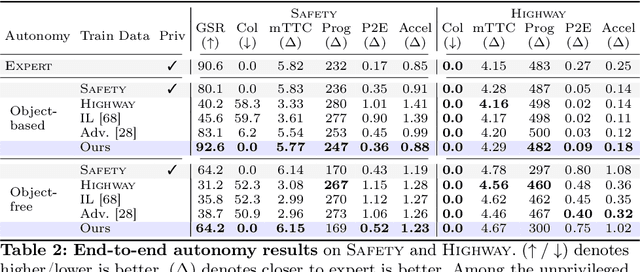
Abstract:Large-scale data is crucial for learning realistic and capable driving policies. However, it can be impractical to rely on scaling datasets with real data alone. The majority of driving data is uninteresting, and deliberately collecting new long-tail scenarios is expensive and unsafe. We propose asymmetric self-play to scale beyond real data with additional challenging, solvable, and realistic synthetic scenarios. Our approach pairs a teacher that learns to generate scenarios it can solve but the student cannot, with a student that learns to solve them. When applied to traffic simulation, we learn realistic policies with significantly fewer collisions in both nominal and long-tail scenarios. Our policies further zero-shot transfer to generate training data for end-to-end autonomy, significantly outperforming state-of-the-art adversarial approaches, or using real data alone. For more information, visit https://waabi.ai/selfplay .
Manifold Contrastive Learning with Variational Lie Group Operators
Jun 23, 2023Abstract:Self-supervised learning of deep neural networks has become a prevalent paradigm for learning representations that transfer to a variety of downstream tasks. Similar to proposed models of the ventral stream of biological vision, it is observed that these networks lead to a separation of category manifolds in the representations of the penultimate layer. Although this observation matches the manifold hypothesis of representation learning, current self-supervised approaches are limited in their ability to explicitly model this manifold. Indeed, current approaches often only apply augmentations from a pre-specified set of "positive pairs" during learning. In this work, we propose a contrastive learning approach that directly models the latent manifold using Lie group operators parameterized by coefficients with a sparsity-promoting prior. A variational distribution over these coefficients provides a generative model of the manifold, with samples which provide feature augmentations applicable both during contrastive training and downstream tasks. Additionally, learned coefficient distributions provide a quantification of which transformations are most likely at each point on the manifold while preserving identity. We demonstrate benefits in self-supervised benchmarks for image datasets, as well as a downstream semi-supervised task. In the former case, we demonstrate that the proposed methods can effectively apply manifold feature augmentations and improve learning both with and without a projection head. In the latter case, we demonstrate that feature augmentations sampled from learned Lie group operators can improve classification performance when using few labels.
PrefGen: Preference Guided Image Generation with Relative Attributes
Apr 01, 2023Abstract:Deep generative models have the capacity to render high fidelity images of content like human faces. Recently, there has been substantial progress in conditionally generating images with specific quantitative attributes, like the emotion conveyed by one's face. These methods typically require a user to explicitly quantify the desired intensity of a visual attribute. A limitation of this method is that many attributes, like how "angry" a human face looks, are difficult for a user to precisely quantify. However, a user would be able to reliably say which of two faces seems "angrier". Following this premise, we develop the $\textit{PrefGen}$ system, which allows users to control the relative attributes of generated images by presenting them with simple paired comparison queries of the form "do you prefer image $a$ or image $b$?" Using information from a sequence of query responses, we can estimate user preferences over a set of image attributes and perform preference-guided image editing and generation. Furthermore, to make preference localization feasible and efficient, we apply an active query selection strategy. We demonstrate the success of this approach using a StyleGAN2 generator on the task of human face editing. Additionally, we demonstrate how our approach can be combined with CLIP, allowing a user to edit the relative intensity of attributes specified by text prompts. Code at https://github.com/helblazer811/PrefGen.
Active Learning of Ordinal Embeddings: A User Study on Football Data
Jul 26, 2022
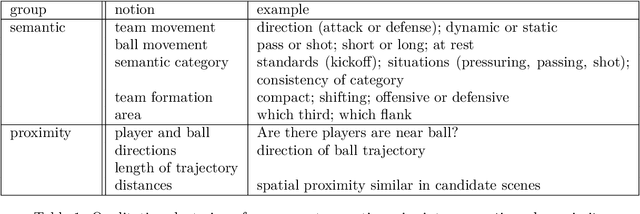
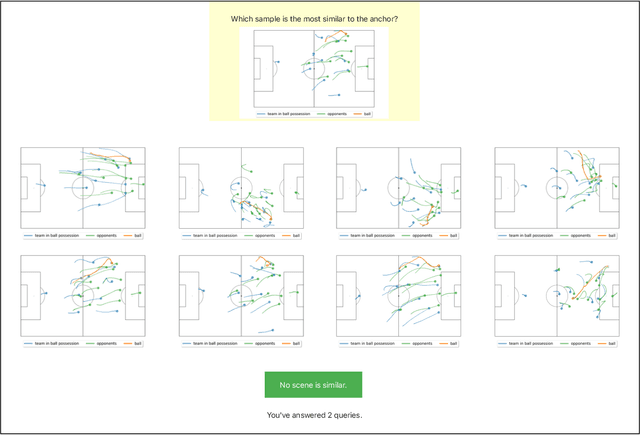

Abstract:Humans innately measure distance between instances in an unlabeled dataset using an unknown similarity function. Distance metrics can only serve as proxy for similarity in information retrieval of similar instances. Learning a good similarity function from human annotations improves the quality of retrievals. This work uses deep metric learning to learn these user-defined similarity functions from few annotations for a large football trajectory dataset. We adapt an entropy-based active learning method with recent work from triplet mining to collect easy-to-answer but still informative annotations from human participants and use them to train a deep convolutional network that generalizes to unseen samples. Our user study shows that our approach improves the quality of the information retrieval compared to a previous deep metric learning approach that relies on a Siamese network. Specifically, we shed light on the strengths and weaknesses of passive sampling heuristics and active learners alike by analyzing the participants' response efficacy. To this end, we collect accuracy, algorithmic time complexity, the participants' fatigue and time-to-response, qualitative self-assessment and statements, as well as the effects of mixed-expertise annotators and their consistency on model performance and transfer-learning.
Variational Sparse Coding with Learned Thresholding
May 07, 2022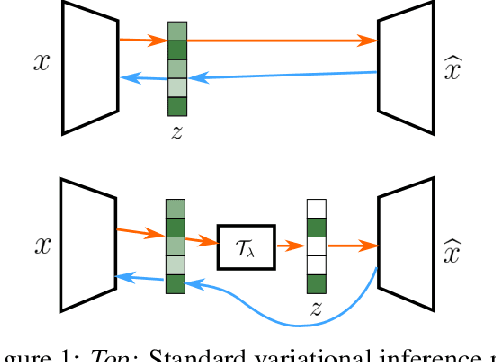
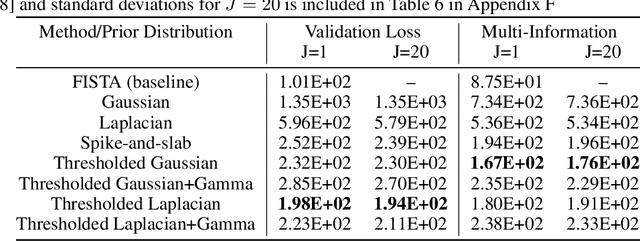
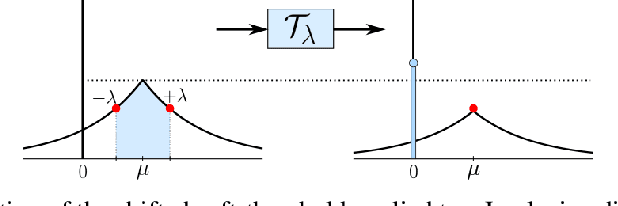

Abstract:Sparse coding strategies have been lauded for their parsimonious representations of data that leverage low dimensional structure. However, inference of these codes typically relies on an optimization procedure with poor computational scaling in high-dimensional problems. For example, sparse inference in the representations learned in the high-dimensional intermediary layers of deep neural networks (DNNs) requires an iterative minimization to be performed at each training step. As such, recent, quick methods in variational inference have been proposed to infer sparse codes by learning a distribution over the codes with a DNN. In this work, we propose a new approach to variational sparse coding that allows us to learn sparse distributions by thresholding samples, avoiding the use of problematic relaxations. We first evaluate and analyze our method by training a linear generator, showing that it has superior performance, statistical efficiency, and gradient estimation compared to other sparse distributions. We then compare to a standard variational autoencoder using a DNN generator on the Fashion MNIST and CelebA datasets
Oracle Guided Image Synthesis with Relative Queries
Apr 28, 2022
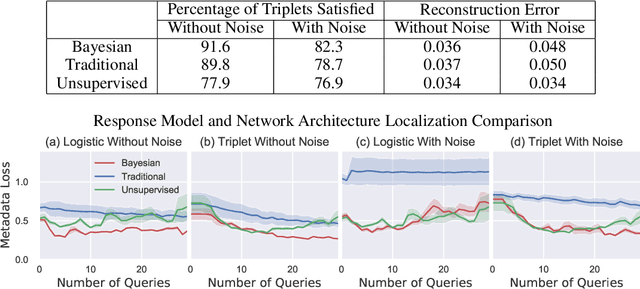
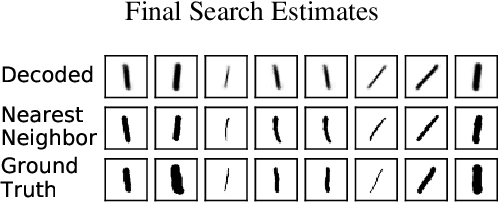
Abstract:Isolating and controlling specific features in the outputs of generative models in a user-friendly way is a difficult and open-ended problem. We develop techniques that allow an oracle user to generate an image they are envisioning in their head by answering a sequence of relative queries of the form \textit{"do you prefer image $a$ or image $b$?"} Our framework consists of a Conditional VAE that uses the collected relative queries to partition the latent space into preference-relevant features and non-preference-relevant features. We then use the user's responses to relative queries to determine the preference-relevant features that correspond to their envisioned output image. Additionally, we develop techniques for modeling the uncertainty in images' predicted preference-relevant features, allowing our framework to generalize to scenarios in which the relative query training set contains noise.
Learning Identity-Preserving Transformations on Data Manifolds
Jun 22, 2021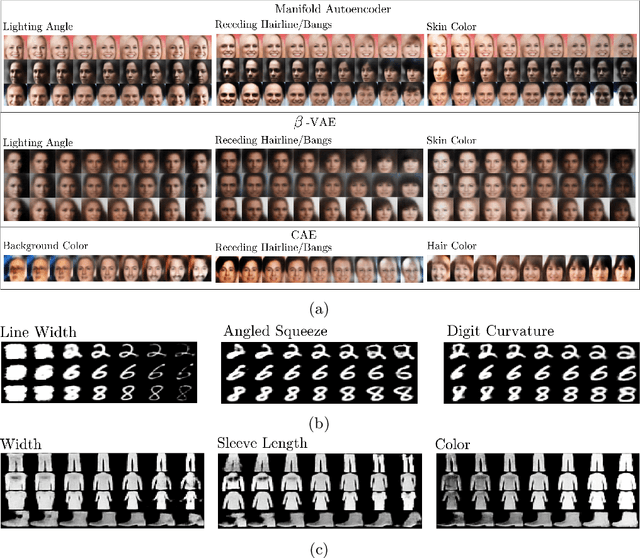
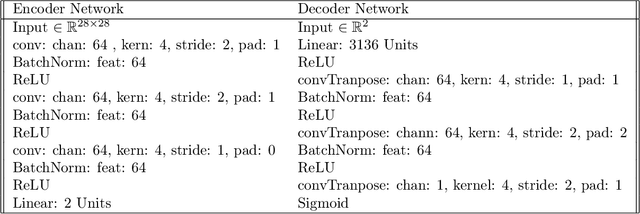

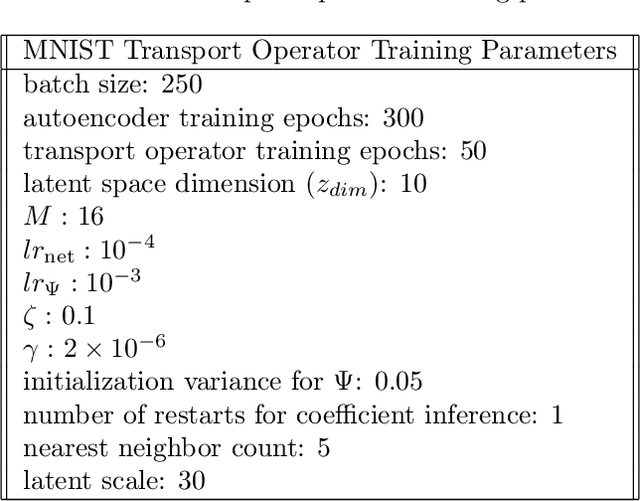
Abstract:Many machine learning techniques incorporate identity-preserving transformations into their models to generalize their performance to previously unseen data. These transformations are typically selected from a set of functions that are known to maintain the identity of an input when applied (e.g., rotation, translation, flipping, and scaling). However, there are many natural variations that cannot be labeled for supervision or defined through examination of the data. As suggested by the manifold hypothesis, many of these natural variations live on or near a low-dimensional, nonlinear manifold. Several techniques represent manifold variations through a set of learned Lie group operators that define directions of motion on the manifold. However theses approaches are limited because they require transformation labels when training their models and they lack a method for determining which regions of the manifold are appropriate for applying each specific operator. We address these limitations by introducing a learning strategy that does not require transformation labels and developing a method that learns the local regions where each operator is likely to be used while preserving the identity of inputs. Experiments on MNIST and Fashion MNIST highlight our model's ability to learn identity-preserving transformations on multi-class datasets. Additionally, we train on CelebA to showcase our model's ability to learn semantically meaningful transformations on complex datasets in an unsupervised manner.
 Add to Chrome
Add to Chrome Add to Firefox
Add to Firefox Add to Edge
Add to Edge